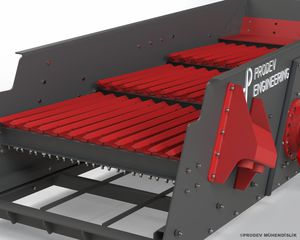

- Products
- Catalogs
- News & Trends
- Exhibitions
Process screener PROSCREEN-I seriesvibratingfor bulk materialsinclined
Add to favorites
Compare this product
Characteristics
- Applications
- process
- Type
- vibrating
- Material
- for bulk materials
- Other characteristics
- inclined, 3-deck, 4-deck, 2-deck
- Engine power
Max.: 30 kW
(40.79 hp)Min.: 5.5 kW
(7.48 hp)
Description
Inclined screens are very important for all mineral processes. The process of grouping the bulk material containing pieces of different sizes in at least two size ranges is called screening. The screening process is referred to as the "classification process" in mineral processes.
Screening panels with specific sizes of mesh are attached to the screen body. While the fed material moves on the screen panel with the vibration of the body, the pieces smaller than the mesh gap pass to a lower screen panel with a smaller mesh size to be screened again.
What is Screening?
The basic usage of all vibrating screen is the same. The parts smaller than the mesh opening of the screen panel can pass under the screen panel, and these parts are called under-screen materials, and the materials larger than the mesh opening go towards the front chute before they can pass through the screen panel. These materials are called screened material. The screening efficiency increases as the particles pass through the mesh opening.
Inclined screens are generally manufactured as 2, 3 or 4 layers. On each deck, there are structures with herringbone geometry, called screen frames, and carries the screen panel. If the material is small enough to pass through the eye gap in the deck it is in, it passes to a lower deck, otherwise it passes from the end of the deck to the front chute. A chute at the pouring point of the screen transmits the over screen material from each layer to the next stage without mixing them.
Heart of the Plant
Since inclined screens are very preferred in crushing and screening processes, they are referred to as standard type.
*Prices are pre-tax. They exclude delivery charges and customs duties and do not include additional charges for installation or activation options. Prices are indicative only and may vary by country, with changes to the cost of raw materials and exchange rates.


